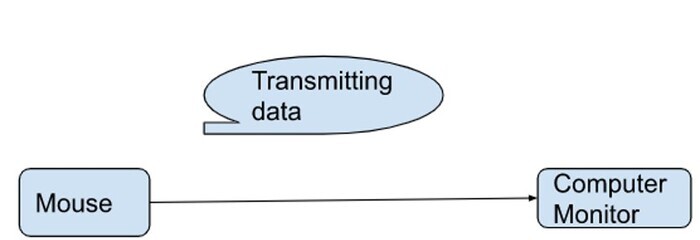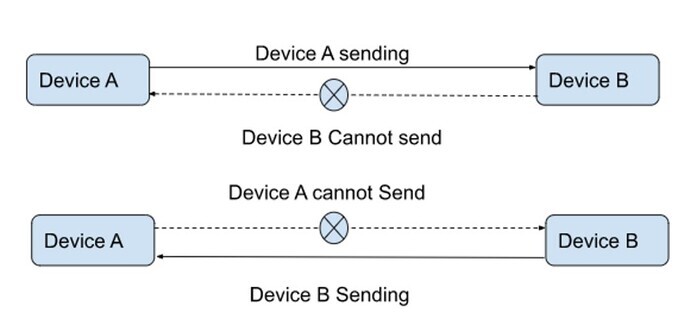
 Data Structure
Data Structure Networking
Networking RDBMS
RDBMS Operating System
Operating System Java
Java MS Excel
MS Excel iOS
iOS HTML
HTML CSS
CSS Android
Android Python
Python C Programming
C Programming C++
C++ C#
C# MongoDB
MongoDB MySQL
MySQL Javascript
Javascript PHP
PHP
- Selected Reading
- UPSC IAS Exams Notes
- Developer's Best Practices
- Questions and Answers
- Effective Resume Writing
- HR Interview Questions
- Computer Glossary
- Who is Who
Transmission mode
Communication is defined as the transfer or sharing of data between any two individuals through a medium and the medium can be wired or wireless. In a computer network, the OSI (Open System Interconnection) model has seven layers for the communication networks. The First layer of OSI is the Physical layer that uses the Transmission mode for transferring the raw data to other devices using a physical medium. Transferring modes refer to the process of transferring data from one point to the other point or device over a particular network. The Channel between the two devices can be buses or networks. The communication channel between the two points includes an optical fiber cable, wireless communication, and a copper wired channel. These data are transferred between the devices using Electro Magnetic waves.
Transmission Mode
Data Transmission
Transmission of raw data from one medium to another medium or from one point to another point and the way it is transmitted is called transmission mode. As the transmission of data is coupled with the flow of direction, it is also called a Directional mode or Communication mode.
Components Needed for Transmission
There are mainly five components used during the transmission. They are ?
Raw data ? The data that needs to be transferred between the devices.
Sender ? It can be any device that can send the raw data.
Receiver ? It is the device that receives the data that the sender sends.
Transmission medium ? The medium between the sender and receiver can be wired, wireless, or both types.
Protocol ? The Protocol can vary according to the modes of transmission.
Types of Transmission modes based on the direction of Exchange of Information
The Transmission modes are primarily divided into three types based on the direction in which data flows through an interaction or communication channel. They are ?
Simplex Transmission Mode
Half Duplex Transmission Mode
Full Duplex Transmission Mode
Simplex Mode
The Data is transmitted from one device to another device; it follows only one direction with full capacity. In this, the sender sends the raw data or processed information to the receiver without any acknowledgment or permission for the transmission of data in this mode. The sender only has the right or access to send the data to the receiver and in turn, the receiver can't send the data back to the sender. It is also called one-way communication or unidirectional.

Example of Simplex mode
Data is transmitted from the Mouse to the Monitor. When we move the mouse, we see the outputs on the monitor and the monitor does not send any feedback or response back to the mouse.
In Television broadcasting, the broadcasters send the data in the form of signals but from the receiver end no signal is sent back.
Some of the other systems are Radio Broadcasting, Loudspeaker, and keyboard to monitor are also a Simplex transmission mode.
Half Duplex Mode
Half duplex mode is the mechanism of transferring the data from one device to another or from sender to receiver and from receiver to sender, but not simultaneously. It has a carrier medium that also only one device to travel at a time. In this mode, either Device A needs to send the data or Device B has to send the data. It is like communication is in one direction at a time, but the transmission of data is done in both ways. It is also known as the Semi duplex system.

Examples of Half Duplex Mode
Walkie-Talkie is a Half-Duplex device. In this, the person in location A transfers their data in the form of voice and the person receiver end waits for the data to reach. Then only the other person can send or reply to the data you received from the sender again.
USB 2.0 (Universal Serial Bus) supports half-duplex communication.
Full Duplex Transmission mode
Full Duplex mode is the transmission of data between two devices simultaneously. It is a two-way communication. The Sender can send and receive the data from the other end device simultaneously. In this the carrier or the bus need not wait for the other device, it can send/receive the data simultaneously.
A Full Duplex is also known as the Double Duplex as it has bidirectional communication.

Examples of Full Duplex Mode
In MODEM we send and receive the information at the same time.
Telephone or mobile communication helps people on both ends to talk simultaneously.
Types of Transmission modes based on Synchronization
The Transmission mode based on the synchronization can be of two types,
Synchronous
Asynchronous
Synchronous Mode
Transmission of data is performed bit by bit in which bits are sent an order to the receiver without using the stopping or starting bits.
Asynchronous Mode
Transmission of data is performed bit by bit in which bits are sent to the receiver using the stopping or starting bits in the transmission message bits.
Duplex communication is a point-to-point system in which two or more devices are connected over a network that can communicate with each other. The Three Transmission modes based on the direction of data flow have varying performance; from that Full Duplex has superior performance compared to simplex and half duplex transmission modes.

